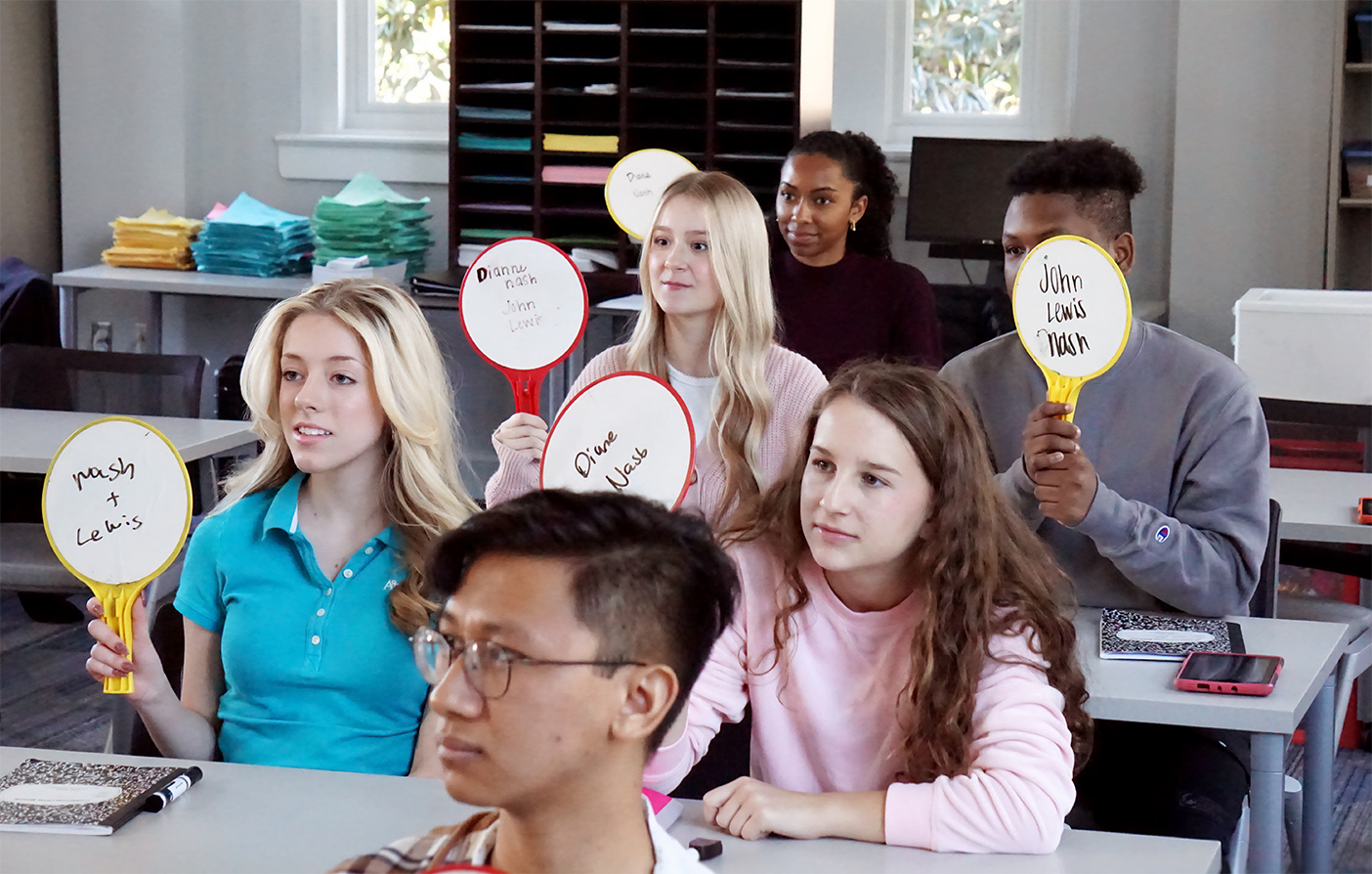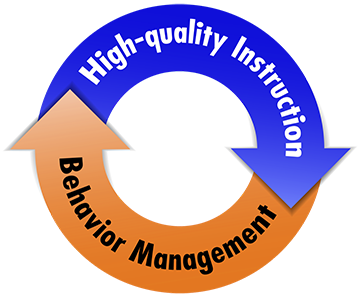What strategies can educators implement to prevent or address challenging behaviors?
Page 6: Opportunities to Respond
 Opportunities to respond (OTR) involves giving students frequent chances to answer questions or prompts in a set amount of time (e.g., 3-5 per minute). Rather than one student responding at a time, all students respond simultaneously using verbal responses (e.g., choral response) or non-verbal responses (e.g., thumbs up/thumbs down). When students have frequent opportunities to respond to questions and prompts, they are less likely to become off-task or engage in challenging or disruptive behaviors.
Opportunities to respond (OTR) involves giving students frequent chances to answer questions or prompts in a set amount of time (e.g., 3-5 per minute). Rather than one student responding at a time, all students respond simultaneously using verbal responses (e.g., choral response) or non-verbal responses (e.g., thumbs up/thumbs down). When students have frequent opportunities to respond to questions and prompts, they are less likely to become off-task or engage in challenging or disruptive behaviors.
OTR is often used when teaching the entire class and is most effective when used to review material already taught, making sure students have at least a basic understanding of the academic content. Because increased academic engagement decreases rates of challenging behaviors, OTR’s benefits are twofold: helping students increase fluency and subject area content knowledge while also effectively promoting and reinforcing student participation and engagement.
For Your Information
 Academics and behavior are interlinked: When teachers provide high-quality instruction, students tend to be more engaged in the lesson, and exhibit fewer disruptive behaviors; when teachers effectively manage student behavior, they have more time to provide high-quality instruction.
Academics and behavior are interlinked: When teachers provide high-quality instruction, students tend to be more engaged in the lesson, and exhibit fewer disruptive behaviors; when teachers effectively manage student behavior, they have more time to provide high-quality instruction.
Research Shows
- Opportunities to respond has been found to increase on-task behaviors and student engagement:
- For students with and without disabilities
- Across all grade levels
- During small- and whole-group instruction
(Clarke, Haydon, Bauer & Epperly 2016; Common, Lane, Cantwell, Brunsting, Oakes, Germer, & Bross, 2020; Fitzgerald Leahy, Miller, & Schardt, 2019; MacSuga-Gage & Simonsen, 2015)
- Teachers can intensify instructional and behavioral supports for their students by increasing the number of OTRs.
(Van Camp, Wehby, Martin, Wright, & Sutherland, 2020)
Using the Strategy
To help educators prevent or address challenging behavior, the table below describes the steps to implement opportunities to respond and provides an example.
| Steps | Description | Example |
|
After choosing a content area and a specific objective or skill (e.g., math problems, vocabulary), create a list of questions or prompts based on the content. |
The teacher creates 15 multiple choice questions for students in algebra class for a five-minute practice activity. |
|
Determine how you will ask questions (e.g., note cards with questions, presentation slides). |
The teacher prepares presentation slides with these questions. |
|
Determine how students will respond (e.g., writing answers on dry-erase boards; holding up cards with A, B, C, and D options). |
The teacher instructs students to write their responses (i.e., A, B, C, D) on dry-erase boards. |
|
Offer three to five opportunities to respond per minute to ensure that students are frequently answering questions and staying engaged. |
The teacher projects a multiple-choice question and gives students twenty seconds to write the answer. At the teacher’s prompt, the students hold up their dry-erase boards at the same time. |
|
Be brief and constructive when providing feedback. |
The teacher scans the responses quickly, gives the correct answer, and provides reinforcement and corrective feedback as appropriate. |
In addition to the five steps listed above, the five actions below can be helpful when implementing this practice.
Be ready to ask students three to five questions per minute—if you are planning for a five-minute time period, you will need to have 15-25 questions prepared ahead of time. It’s also a good idea to prepare additional questions in case students move through the questions faster than anticipated.
Explain to students how you will ask questions and how they should respond. When first implementing this strategy, model and practice with students until they understand the process and are consistently able to follow your directions.
Implementing OTR the same way every time may become repetitive and cause students to become less engaged, which sets the stage for challenging behavior. Mix it up! Consider the options below:
- Verbal: Allow students to respond verbally as a whole group (e.g., choral response) or in groups or pairs (e.g., Think-Pair-Share). Keep in mind that students who are quiet or unsure of the answer may find it easier to “hide” in whole group choral responses.
- Non-verbal: Allow students to respond non-verbally (e.g., signaling thumbs up/down, writing answers on note cards, using dry-erase boards).
Think-Pair-Share
Learning strategy that provides students time and structure to think about a given topic or question, pair with a peer and share their own ideas with their partner, and then share their ideas with classmates.
Keep track of student responses to help identify content the students have mastered and what needs to be re-taught or reviewed. For example, if you’ve written questions on note cards, place the card in one of two piles (e.g., “most got correct” or “need more practice”) based on student responses.
Ask students what they thought was helpful about this activity. For example, students may prefer non-verbal responses or like to work with a partner before responding. Students may indicate that you are moving through questions too slowly or too quickly.
In this interview, Yesmery Sanchez explains different ways that teachers can implement opportunities to respond (time: 1:19).

Transcript: Yesmery Sanchez
So with opportunity to respond, we usually have students use whiteboards. They can write their answer quickly, flash their boards when it’s time to share their response. We do the fingers as well to check for understanding or to see if they’re following along with the material. And we’ll have one, two, three, four, and they’ll pick up their fingers based on the answer that they think is best. We also have color tents that we give them. So the way the color tents work, they switch their tent to whatever color they believe matches the response. It looks different in every class. It depends on the teacher and what strategies they want to use to have the kids quickly respond.
It’s an opportunity for my ESL kids to participate in the class and feel confident about their participation. Maybe I might give them the question ahead of time so they can think about it a little longer, or I may provide them with extra supports that can help them feel successful in their approach with the questions. I think it’s important to note that kids don’t always feel comfortable sharing their responses verbally, but when they’re given the opportunity even to silently display a color on their desks with the answer, we’re able to scan the classroom quickly and give an opportunity for all the students to feel involved and confident in their response.
Tier 2 Support
Although OTR can be used as a Tier 1 strategy, it can also be used as a Tier 2 support for students with moderate levels of externalizing or internalizing behaviors. The steps are the same as when used as a Tier 1 support, but for Tier 2 the educator implements OTR with greater intensity (e.g., more frequently). To determine if the strategy is effective, the educator collects and analyzes the data using the following steps:
- Identify the student behavior to be addressed (e.g., student refuses to verbally participate in class discussion) during an instructional period in which the behavior typically occurs (e.g., science, math).
- Collect baseline data on the student behavior for a designated timeframe (e.g., first 20 minutes of class) during the identified instructional period. Collect this data across several days (e.g., 3 to 5 days) to see how often this behavior occurs or how long each episode lasts.
- Implement or intensify OTR and continue to collect data (e.g., same instructional period, same length of time) for 3 to 5 days to determine whether the student’s behavior changes.
- Evaluate the effect of OTR. Compare the implementation data to the baseline data to evaluate whether the strategy has had the desired effect on the student’s behavior.

To make sure you are using this strategy with fidelity, download this OTR implementation checklist. |